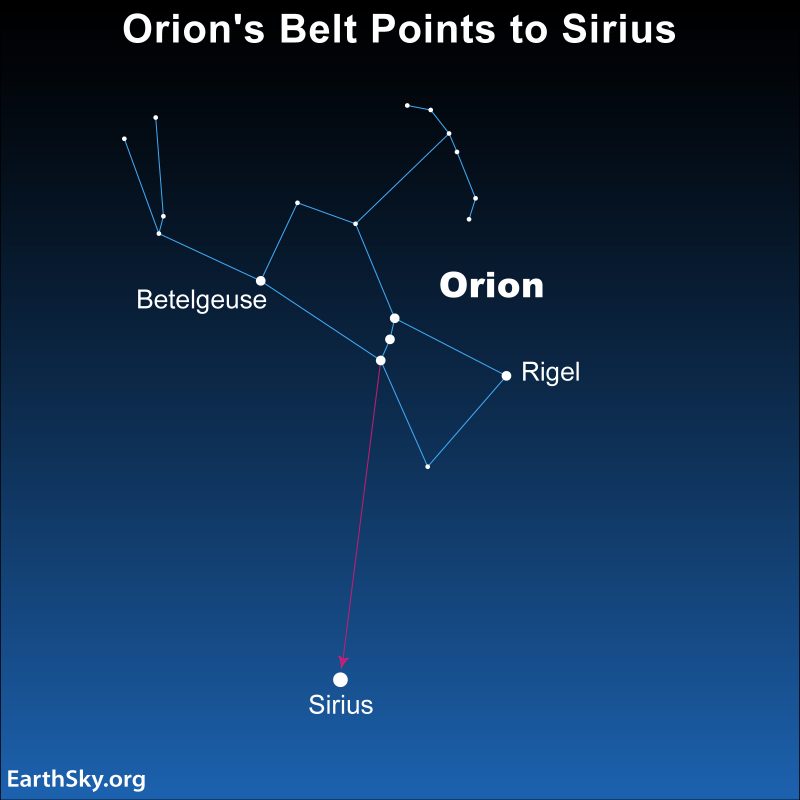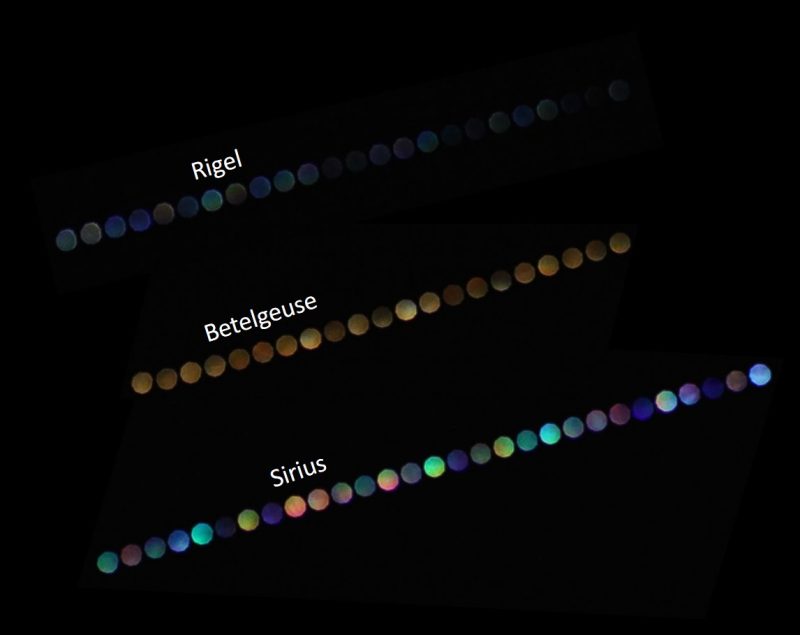
What is that flashing star?
Northern Hemisphere autumn – around the month of October – is when we’re most often asked:
What is that bright star twinkling with red and green flashes?
And, in fact, there are three bright stars you might notice flashing or twinkling fiercely in the October night. You might notice glints of color from all of these stars. They are: Capella in Auriga, Arcturus in Bootes, and Sirius in Canis Major.
Capella is bright. It shines at magnitude 0.24, making it the 6th-brightest star in Earth’s sky, not including our sun. And it’s low in the sky, in the northeast direction, at nightfall or early evening as seen from mid-northern locations, at this time of year. Just step outside this evening and look northeast. See a flashy star? It’s probably Capella. If you could travel to this star in space, you’d find that Capella is really two golden sun, both with roughly the same surface temperature as our sun, but both larger and brighter than our sun. Capella is the brightest star in the constellation Auriga the Charioteer. But since antiquity it’s carried the name Goat Star. You might pick it out just by gazing northeastward from a Northern Hemisphere latitude during the evening hours in October. To be sure you’ve found Capella, look for a little triangle of stars nearby, an asterism called The Kids.
Why do stars flash colors?
The reality is that every star in the sky undergoes the same process as Capella, to produce its colorful twinkling. That is, every star’s light must shine through Earth’s atmosphere before reaching our eyes. But not every star flashes as noticeably as Capella. The flashes are happening because Capella is low in the sky in the evening at this time of year. And, when you look at an object low in the sky, you’re looking through more atmosphere than when the same object is overhead. The atmosphere splits or “refracts” the star’s light, just as a prism splits sunlight.
So that’s the source of Capella’s red and green flashes. Just know that they’re not from the star itself. They’re caused by the refraction of its light in Earth’s atmosphere. When you see Capella higher in the sky, you’ll find that these glints of red and green will disappear. Why are these flashes of color so noticeable with Capella? The reason is simply that it’s a bright star.
Now here’s another bright flashy star you might notice in October:

Arcturus is flashy, too
Arcturus is in the constellation Bootes the Herdsman. It’s an orange-colored star, in the northwest (from northerly latitudes) in the evening in October. You can always know you’ve found Arcturus if you also notice the Big Dipper, also in the northwest in early evening, nearby. The arc of the Big Dipper’s handle can be extended outward to Arcturus. See the chart above.
Arcturus is about the same brightness as Capella, but it’s not as noticeable for one big reason. On October evenings, Capella is ascending in the sky. Arcturus is descending. So Capella shines most of the night, while Arcturus not long after the sun.
Our nomination for 3rd flashiest star of October is …

Sirius is famous for its twinkling
Sirius in the constellation Canis Major the Greater Dog is the brightest star in the night sky. And this star is famous for twinkling in different colors. Sirius is now in the south before dawn, as seen from the Northern Hemisphere (higher in the sky before dawn for the Southern Hemisphere).
For example, Andy wrote in October:
Early this morning, looking south, I saw a beautiful star, bright and multicolored … Can you identify it for me?
And Paula wrote in October:
This morning two of us got up early. We found a pulsing star straight down the sky below Orion’s Belt. It was pulsing the colors of green, yellow, blue and red like a strobe light. I will search for it every morning as it was so enchanting.
We get many, many questions every autumn about a multicolored star twinkling in the southeastern to southern sky after midnight. Sirius appears to flash different colors when it’s low in the sky. Really, all the stars are flashing different colors, because light is composed of all the colors of a rainbow, and the journey through our atmosphere breaks starlight into its component colors via refraction. But you don’t notice the colors of the other stars much, because they’re not as bright as Sirius (or Capella or Arcturus).
Since our atmosphere is causing the light to break into its colors, and since Sirius is often seen low in the sky now (where you are peering at it through a thicker layer of atmosphere than when it’s overhead), the flashing colors of Sirius are very obvious. When Sirius is higher in the sky – which it is close to dawn in the month of October – or in the evening sky in January and February – you’ll find that Sirius shines with a steadier, whiter light.
Enjoy October’s flashy stars!
More about Sirius: Dog Star and brightest star
Want a specific view from your location on the globe? Visit Stellarium and enter your location.

Bottom line: We get many questions about a bright, colorful, twinkling stars on these October nights. There are three stars we hear about most often: Capella, Arcturus and Sirius.
Donate: Your support means the world to us
The post Flashing star in autumn? Here are 3 candidates first appeared on EarthSky.
0 Commentaires